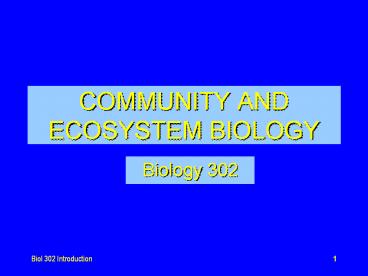COMMUNITY AND ECOSYSTEM BIOLOGY PowerPoint PPT Presentation
1 / 33
Title: COMMUNITY AND ECOSYSTEM BIOLOGY
1
COMMUNITY AND ECOSYSTEM BIOLOGY
- Biology 302
2
(No Transcript)
3
(No Transcript)
4
(No Transcript)
5
(No Transcript)
6
FIELDWORK IN DANGEROUS PLACES
7
(No Transcript)
8
(No Transcript)
9
(No Transcript)
10
(No Transcript)
11
- THIRD YEAR ECOLOGY
- FALL Population ecology (BIOL 303)
- SPRING Community ecology ( ecosystems)
- Community structure
- Succession
- Productivity
- Biodiversity
- Nutrient cycling etc.
12
COMMUNITY STRUCTURE
13
READINGS for this lecture series KREBS cpt 20.
The Nature of the Community KREBS cpt 12. Pp
190 - 199 KREBS cpt 23. Predation Competition
(selected) KREBS cpt 24. Disturbance Pp 485 - 501
14
COMMUNITY ECOLOGY COMMUNITY STRUCTURE Doing
science at the community level presents daunting
problems because data bases may be enormous and
complex.
Krebs Fig 23.4 p464
15
- FIRST STEP is to DESCRIBE by searching for
PATTERNS in community structure and composition. - recognition of patterns is a big first step is
all sciences.
16
- FIRST STEP is to DESCRIBE by searching for
PATTERNS in community structure and composition. - recognition of patterns is a big first step is
all sciences.
2. Recognition of pattern leads to formulation
of HYPOTHESES ABOUT THE CAUSES of the pattern
17
- FIRST STEP is to DESCRIBE by searching for
PATTERNS in community structure and composition. - recognition of patterns is a big first step is
all sciences.
2. Recognition of pattern leads to formulation of
HYPOTHESES ABOUT THE CAUSES of the pattern
3. Hypothesis testing by doing EXPERIMENTS or
making further observations.
18
THE NATURE OF THE COMMUNITY Krebs general read
of cpt. 20
1. What is a community?
2. How to describe a community?
3. Does a community have boundaries?
19
1. Is the community real?
abstraction? 2. Can you tell when you leave one
community and enter another? prairie and
deciduous forest of eastern USA (world map.
Krebs p395 Fig. 20.6) at Lytton on the
Hope/Cache Creek Rd. 3. Or, do communities
generally change along some environmental
gradient?
20
1. Is the community real?
abstraction? 2. Can you tell when you leave one
community and enter another? prairie and
deciduous forest of eastern USA (world map.
Krebs p395 Fig. 20.6) at Lytton on the
Hope/Cache Creek Rd. 3. Or, do communities
generally change along some environmental
gradient?
21
ABCDEFGHIJKLMNOP
HIJKLMNOP
ABCDEFG
ABCDEFGHIJKLMNOP
22
WORLD VEGETATION MAP
23
Krebs Fig. 20.6 p395
24
1. Is the community real?
abstraction? 2. Can you tell when you leave one
community and enter another? prairie and
deciduous forest of eastern USA (world map.
Krebs p395 Fig. 20.6) at Lytton on the
Hope/Cache Creek Rd. 3. Or, do communities
generally change along some environmental
gradient?
25
Alternative models for vegetation organization
along an environmental gradient (Krebs Fig. 20.5
p394)
Organismic concept
Resource partitioning model
Individualistic concept
Resource partitioning model with several layers
26
Alternative models for vegetation organization
along an environmental gradient (Krebs Fig. 20.5
p394)
Organismic concept
Resource partitioning model
Individualistic concept
Resource partitioning model with several layers
27
Alternative models for vegetation organization
along an environmental gradient (Krebs Fig. 20.5
p394)
Organismic concept
Resource partitioning model
Individualistic concept
Resource partitioning model with several layers
28
Alternative models for vegetation organization
along an environmental gradient (Krebs Fig. 20.5
p394)
Organismic concept
Resource partitioning model
Individualistic concept
Resource partitioning model with several layers
29
Arthur Tansley 1871 - 1955
Frederic Clements 1874 - 1945
Henry Gleason 1882 - 1975
30
CLEMENTS (1916, 1928) ORGANISMIC CONCEPT GLEASON (1926, 1927) INDIVIDUALISTIC CONCEPT
Closely integrated system with birth, growth, maturation, development, death Homeostasis Repair Random assemblages of species that happen to have same growth requirements They may interact
31
CLEMENTS (1916, 1928) ORGANISMIC CONCEPT GLEASON (1926, 1927) INDIVIDUALISTIC CONCEPT
Predictable development Climax Predictable, stable Convergence to sameness Randomness of seed dispersal, establishment etc. Climax Disturbance prevents it Different end points
32
- THE MODERN SYNTHESIS
- quite close to Gleasons view of community
structure and dynamics. - However, we do get some sharp boundaries
- Environmental (Lytton)
- Soils
- Serpentine soils of northern Oregon
- Moisture
- Competition
33
Krebs Fig. 7.9 p95

